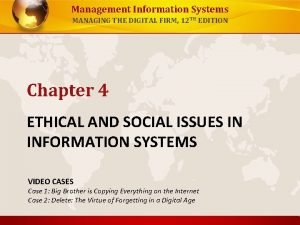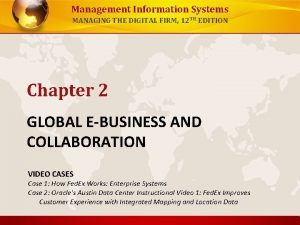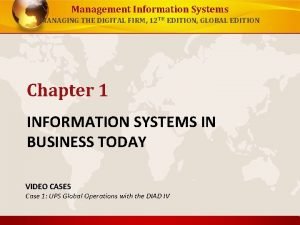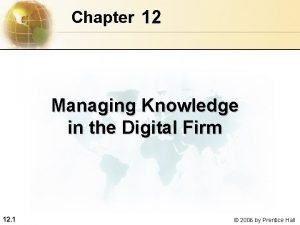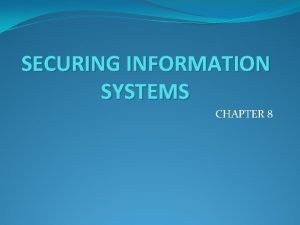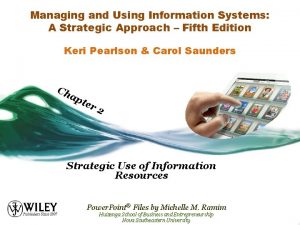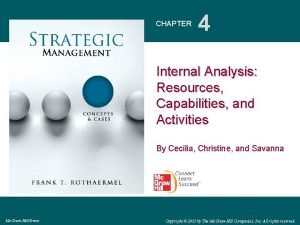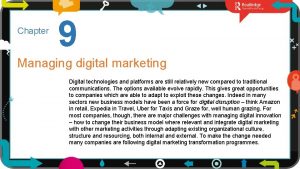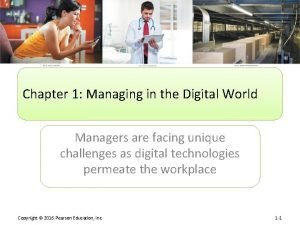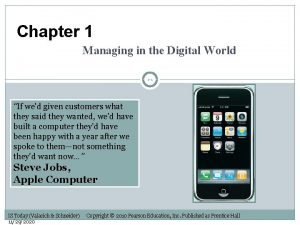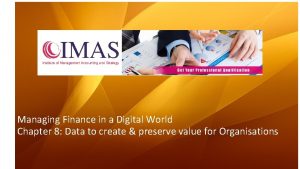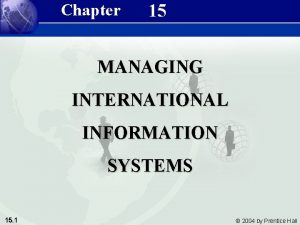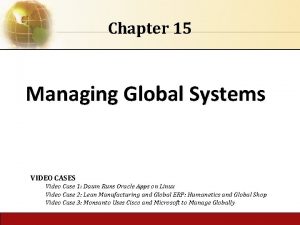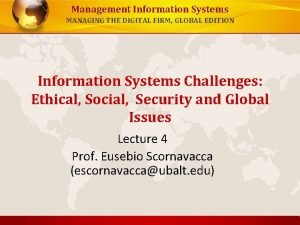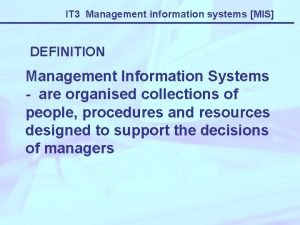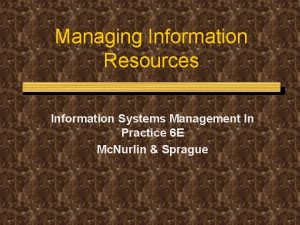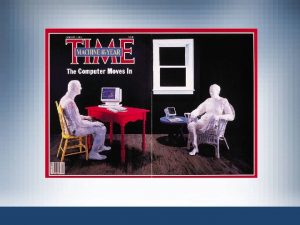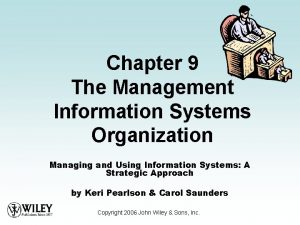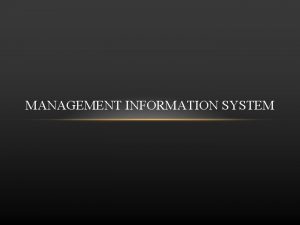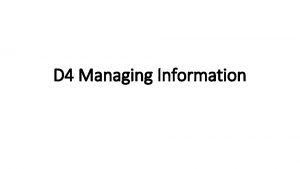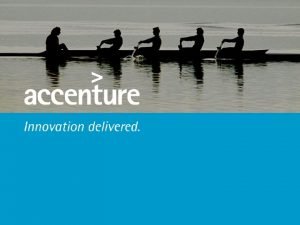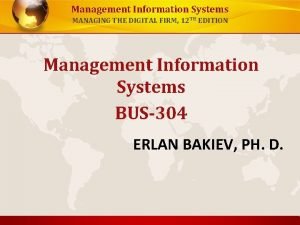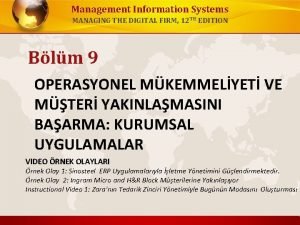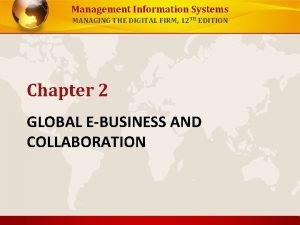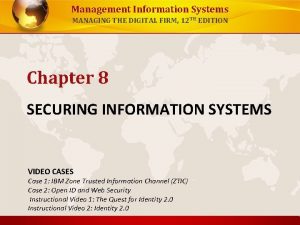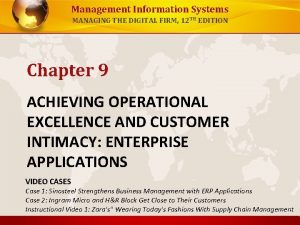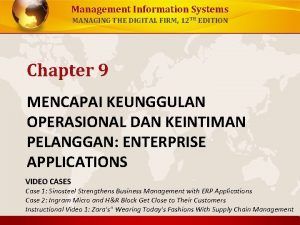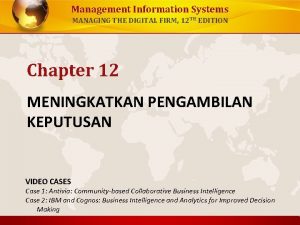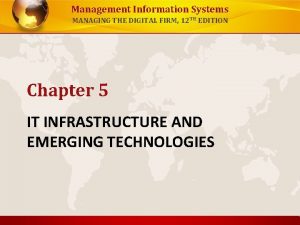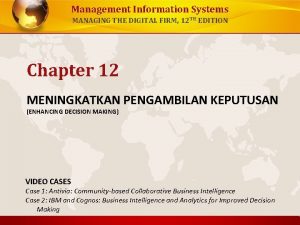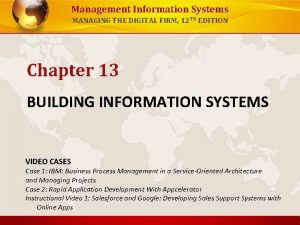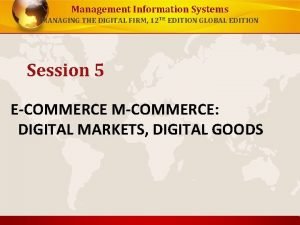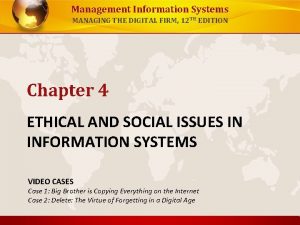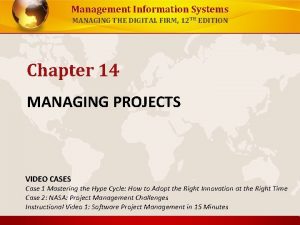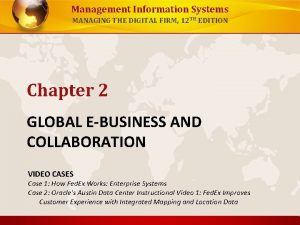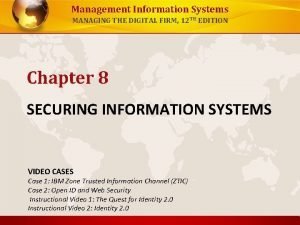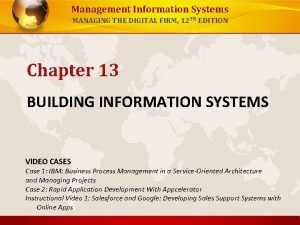Management Information Systems MANAGING THE DIGITAL FIRM 12












































- Slides: 44

Management Information Systems MANAGING THE DIGITAL FIRM, 12 TH EDITION, GLOBAL EDITION Chapter 1 INFORMATION SYSTEMS IN BUSINESS TODAY VIDEO CASES Case 1: UPS Global Operations with the DIAD IV

Management Information Systems CHAPTER 1: INFORMATION IN BUSINESS SYSTEMS TODAY Learning Objectives • Transforming business and relationship to globalization. • Understanding the effects of information systems on business. • Explain why information systems are so essential in business today. • Define an information system and describe its management, organization, and technology components. • Define complementary assets. 2 © Pearson Education 2012

Management Information Systems CHAPTER 1: INFORMATION IN BUSINESS SYSTEMS TODAY The Role of Information Systems in Business Today • How information systems are transforming business – Increase in wireless technology use, Web sites – Increased business use of Web 2. 0 technologies – Cloud computing, mobile digital platform allow more distributed work, decision-making, and collaboration • Globalization opportunities – Internet has drastically reduced costs of operating on global scale – Presents both challenges and opportunities 3 © Pearson Education 2012

Management Information Systems CHAPTER 1: INFORMATION IN BUSINESS SYSTEMS TODAY The Role of Information Systems in Business Today Information Technology Capital Investment FIGURE 1 -1 4 Information technology capital investment, defined as hardware, software, and communications equipment, grew from 32 percent to 52 percent of all invested capital between 1980 and 2009. © Pearson Education 2012

Management Information Systems CHAPTER 1: INFORMATION IN BUSINESS SYSTEMS TODAY The Role of Information Systems in Business Today • In the emerging, fully digital firm – Significant business relationships are digitally enabled and mediated – Core business processes are accomplished through digital networks – Key corporate assets are managed digitally • Digital firms offer greater flexibility in organization and management – Time shifting, space shifting 5 © Pearson Education 2012

Management Information Systems CHAPTER 1: INFORMATION IN BUSINESS SYSTEMS TODAY The Role of Information Systems in Business Today • Business Processes refer to the set of logically related tasks and behaviors that organization develop over time to produce specific business results and the unique manner in which these activities are organized and coordinated. (define in text) • Business Processes (define in Glossary) The unique ways in which organizations coordinate and organize work activities, information, and knowledge to produce a product or service. 6 © Pearson Education 2012

Management Information Systems CHAPTER 1: INFORMATION IN BUSINESS SYSTEMS TODAY The Role of Information Systems in Business Today • Key Corporate assets---intellectual property, core competencies, and financial and human assets ---are managed through digital means. • (why a digital firm is more likely to benefit from globalization than a traditional firm? ) 7 © Pearson Education 2012

Management Information Systems CHAPTER 1: INFORMATION IN BUSINESS SYSTEMS TODAY The Role of Information Systems in Business Today MIS IN YOUR POCKET Read the Interactive Session and discuss the following questions • What are the advantages of using mobile handheld devices? What are the disadvantages? • What features are needed in a mobile to make it a business solution? • What business functions can be performed by using handhelds alone? How have other companies utilized handhelds? 8 © Pearson Education 2012

Management Information Systems CHAPTER 1: INFORMATION IN BUSINESS SYSTEMS TODAY The Role of Information Systems in Business Today • Growing interdependence between ability to use information technology and ability to implement corporate strategies and achieve corporate goals • Business firms invest heavily in information systems to achieve six strategic business objectives: 1. 2. 3. 4. 5. 6. 9 Operational excellence New products, services, and business models Customer and supplier intimacy Improved decision making Competitive advantage Survival © Pearson Education 2012

Management Information Systems References Brynjoltson, Erik and Lorin M. Hitt, “Beyond Computation: Information Technology, Organizational Transformation, and Business Performance, ” Journal of Economic Perspectives 14, No. 4(2000). 10 © Pearson Education 2012

Management Information Systems CHAPTER 1: INFORMATION IN BUSINESS SYSTEMS TODAY The Role of Information Systems in Business Today • Operational excellence: – Improvement of efficiency to attain higher profitability – Information systems, technology an important tool in achieving greater efficiency and productivity – Walmart’s Retail. Link system links suppliers to stores for superior replenishment system(page 45 Walmart>>Target? ? ) 11 © Pearson Education 2012

Management Information Systems CHAPTER 1: INFORMATION IN BUSINESS SYSTEMS TODAY The Role of Information Systems in Business Today • New products, services, and business models: – Business model: describes how company produces, delivers, and sells product or service to create wealth – Information systems and technology a major enabling tool for new products, services, business models • Examples: Apple’s i. Pod, i. Tunes, i. Phone, i. Pad, Google’s Android OS, and Netflix 12 © Pearson Education 2012

Management Information Systems CHAPTER 1: INFORMATION IN BUSINESS SYSTEMS TODAY The Role of Information Systems in Business Today • Customer and supplier intimacy: – Serving customers well leads to customers returning, which raises revenues and profits • Example: High-end hotels that use computers to track customer preferences and use to monitor and customize environment – Intimacy with suppliers allows them to provide vital inputs, which lowers costs • Example: J. C. Penney’s information system which links sales records to contract manufacturer 13 © Pearson Education 2012

Management Information Systems CHAPTER 1: INFORMATION IN BUSINESS SYSTEMS TODAY The Role of Information Systems in Business Today • Improved decision making – Without accurate information: • Managers must use forecasts, best guesses, luck • Leads to: – Overproduction, underproduction of goods and services – Misallocation of resources – Poor response times • Poor outcomes raise costs, lose customers – Example: Verizon’s Web-based digital dashboard to provide managers with real-time data on customer complaints, network performance, line outages, etc. 14 © Pearson Education 2012

Management Information Systems CHAPTER 1: INFORMATION IN BUSINESS SYSTEMS TODAY The Role of Information Systems in Business Today • Operational excellence: – Improvement of efficiency to attain higher profitability • New products, services, and business models: – Enabled by technology • Customer and supplier intimacy: – Serving customers raises revenues and profits – Better communication with suppliers lowers costs • Improved decision making – More accurate data leads to better decisions 15 © Pearson Education 2012

Management Information Systems CHAPTER 1: INFORMATION IN BUSINESS SYSTEMS TODAY The Role of Information Systems in Business Today • Competitive advantage – Delivering better performance – Charging less for superior products – Responding to customers and suppliers in real time – Examples: Apple, Walmart, UPS 16 © Pearson Education 2012

Management Information Systems CHAPTER 1: INFORMATION IN BUSINESS SYSTEMS TODAY The Role of Information Systems in Business Today • Survival – Information technologies as necessity of business – May be: • Industry-level changes, e. g. Citibank’s introduction of ATMs • Governmental regulations requiring recordkeeping – Examples: Toxic Substances Control Act, Sarbanes. Oxley Act 17 © Pearson Education 2012

Management Information Systems CHAPTER 1: INFORMATION IN BUSINESS SYSTEMS TODAY The Role of Information Systems in Business Today The Interdependence Between Organizations and Information Technology Figure 1. 2 18 In contemporary systems there is a growing interdependence between a firm’s information systems and its business capabilities. Changes in strategy, rules, and business processes increasingly require changes in hardware, software, databases, and telecommunications. Often, what the organization would like to do depends on what its systems will permit it to do. © Pearson Education 2012

Management Information Systems CHAPTER 1: INFORMATION IN BUSINESS SYSTEMS TODAY Perspectives on Information Systems • Information system: – Set of interrelated components – Collect, process, store, and distribute information – Support decision making, coordination, and control • Information vs. data – Data are streams of raw facts – Information is data shaped into meaningful form 19 © Pearson Education 2012

Management Information Systems CHAPTER 1: INFORMATION IN BUSINESS SYSTEMS TODAY Perspectives on Information Systems Data and Information Figure 1. 3 20 Raw data from a supermarket checkout counter can be processed and organized to produce meaningful information, such as the total unit sales of dish detergent or the total sales revenue from dish detergent for a specific store or sales territory. © Pearson Education 2012

Management Information Systems CHAPTER 1: INFORMATION IN BUSINESS SYSTEMS TODAY Perspectives on Information Systems • Three activities of information systems produce information organizations need 1. Input: Captures raw data from organization or external environment 2. Processing: Converts raw data into meaningful form 3. Output: Transfers processed information to people or activities that use it 21 © Pearson Education 2012

Management Information Systems CHAPTER 1: INFORMATION IN BUSINESS SYSTEMS TODAY Perspectives on Information Systems • Feedback: – Output returned to appropriate members of organization to help evaluate or correct input stage • Computer/Computer program vs. information system – Computers and software technical foundation and tools, similar to the material and tools used to build a house 22 © Pearson Education 2012

Management Information Systems CHAPTER 1: INFORMATION IN BUSINESS SYSTEMS TODAY Perspectives on Information Systems Functions of an Information System An information system contains information about an organization and its surrounding environment. Three basic activities—input, processing, and output— produce the information organizations need. Feedback is output returned to appropriate people or activities in the organization to evaluate and refine the input. Environmental actors, such as customers, suppliers, competitors, stockholders, and regulatory agencies, interact with the organization and its information systems. Figure 1. 4 23 © Pearson Education 2012

Management Information Systems CHAPTER 1: INFORMATION IN BUSINESS SYSTEMS TODAY Perspectives on Information Systems Are More Than Computers Using information systems effectively requires an understanding of the organization, management, and information technology shaping the systems. An information system creates value for the firm as an organizational and management solution to challenges posed by the environment. Figure 1. 5 24 © Pearson Education 2012

Management Information Systems CHAPTER 1: INFORMATION IN BUSINESS SYSTEMS TODAY Perspectives on Information Systems • Organizational dimension of information systems – Hierarchy of authority, responsibility • Senior management • Middle management • Operational management • Knowledge workers • Data workers • Production or service workers 25 © Pearson Education 2012

Management Information Systems CHAPTER 1: INFORMATION IN BUSINESS SYSTEMS TODAY Perspectives on Information Systems Levels in a Firm Business organizations are hierarchies consisting of three principal levels: senior management, middle management, and operational management. Information systems serve each of these levels. Scientists and knowledge workers often work with middle management. Figure 1. 6 26 © Pearson Education 2012

Management Information Systems CHAPTER 1: INFORMATION IN BUSINESS SYSTEMS TODAY Perspectives on Information Systems • Information System Literacy: encompasses an understanding of the management and organizational dimensions of systems as well as the technical dimensions of systems. • Computer literacy: In contrast, focuses primarily on knowledge of information technology. 27 © Pearson Education 2012

Management Information Systems CHAPTER 1: INFORMATION IN BUSINESS SYSTEMS TODAY Perspectives on Information Systems • Organizational dimension of information systems (cont. ) – Separation of business functions • • Sales and marketing Human resources Finance and accounting Manufacturing and production – Unique business processes – Unique business culture – Organizational politics 28 © Pearson Education 2012

Management Information Systems CHAPTER 1: INFORMATION IN BUSINESS SYSTEMS TODAY Perspectives on Information Systems • Management dimension of information systems – Managers set organizational strategy for responding to business challenges – In addition, managers must act creatively: • Creation of new products and services • Occasionally re-creating the organization 29 © Pearson Education 2012

Management Information Systems CHAPTER 1: INFORMATION IN BUSINESS SYSTEMS TODAY Perspectives on Information Systems • Technology dimension of information systems – Computer hardware and software – Data management technology – Networking and telecommunications technology • Networks, the Internet, intranets and extranets, World Wide Web – IT infrastructure: provides platform that system is built on 30 © Pearson Education 2012

Management Information Systems CHAPTER 1: INFORMATION IN BUSINESS SYSTEMS TODAY Perspectives on Information Systems UPS COMPETES GLOBALLY WITH INFORMATION TECHNOLOGY Read the Interactive Session and discuss the following questions • What are the inputs, processing, and outputs of UPS’s package tracking system? • What technologies are used by UPS? How are these technologies related to UPS’s business strategy? • What problems do UPS’s information systems solve? What would happen if these systems were not available? 31 © Pearson Education 2012

Management Information Systems CHAPTER 1: INFORMATION IN BUSINESS SYSTEMS TODAY Perspectives on Information Systems • Dimensions of UPS tracking system – Organizational: • Procedures for tracking packages and managing inventory and provide information – Management: • Monitor service levels and costs – Technology: • Handheld computers, bar-code scanners, networks, desktop computers, etc. 32 © Pearson Education 2012

Management Information Systems CHAPTER 1: INFORMATION IN BUSINESS SYSTEMS TODAY Perspectives on Information Systems • Business perspective on information systems: – Information system is instrument for creating value – Investments in information technology will result in superior returns: • Productivity increases • Revenue increases • Superior long-term strategic positioning 33 © Pearson Education 2012

Management Information Systems CHAPTER 1: INFORMATION IN BUSINESS SYSTEMS TODAY Perspectives on Information Systems • Business information value chain – Raw data acquired and transformed through stages that add value to that information – Value of information system determined in part by extent to which it leads to better decisions, greater efficiency, and higher profits • Business perspective: – Calls attention to organizational and managerial nature of information systems 34 © Pearson Education 2012

Management Information Systems CHAPTER 1: INFORMATION IN BUSINESS SYSTEMS TODAY Perspectives on Information Systems The Business Information Value Chain Figure 1 -7 35 From a business perspective, information systems are part of a series of value-adding activities for acquiring, transforming, and distributing information that managers can use to improve decision making, enhance organizational performance, and, ultimately, increase firm profitability. © Pearson Education 2012

Management Information Systems CHAPTER 1: INFORMATION IN BUSINESS SYSTEMS TODAY Perspectives on Information Systems Variation in Returns On Information Technology Investment Although, on average, investments in information technology produce returns far above those returned by other investments, there is considerable variation across firms. Figure 1. 8 36 © Pearson Education 2012

Management Information Systems CHAPTER 1: INFORMATION IN BUSINESS SYSTEMS TODAY Perspectives on Information Systems • Investing in information technology does not guarantee good returns • Considerable variation in the returns firms receive from systems investments • Factors: – Adopting the right business model – Investing in complementary assets (organizational and management capital) 37 © Pearson Education 2012

Management Information Systems CHAPTER 1: INFORMATION IN BUSINESS SYSTEMS TODAY Perspectives on Information Systems • Complementary assets: – Assets required to derive value from a primary investment – Firms supporting technology investments with investment in complementary assets receive superior returns – E. g. : invest in technology and the people to make it work properly 38 © Pearson Education 2012

Management Information Systems CHAPTER 1: INFORMATION IN BUSINESS SYSTEMS TODAY Perspectives on Information Systems • Complementary assets include: – Organizational assets, e. g. • Appropriate business model • Efficient business processes – Managerial assets, e. g. • Incentives for management innovation • Teamwork and collaborative work environments – Social assets, e. g. • The Internet and telecommunications infrastructure • Technology standards 39 © Pearson Education 2012

Management Information Systems CHAPTER 1: INFORMATION IN BUSINESS SYSTEMS TODAY Contemporary Approaches to Information Systems The study of information systems deals with issues and insights contributed from technical and behavioral disciplines. Figure 1. 9 40 © Pearson Education 2012

Management Information Systems CHAPTER 1: INFORMATION IN BUSINESS SYSTEMS TODAY Contemporary Approaches to Information Systems • Technical approach – Emphasizes mathematically based models – Computer science, management science, operations research • Behavioral approach – Behavioral issues (strategic business integration, implementation, etc. ) – Psychology, economics, sociology 41 © Pearson Education 2012

Management Information Systems CHAPTER 1: INFORMATION IN BUSINESS SYSTEMS TODAY Contemporary Approaches to Information Systems • Management Information Systems – Combines computer science, management science, operations research and practical orientation with behavioral issues • Four main actors – Suppliers of hardware and software – Business firms – Managers and employees – Firm’s environment (legal, social, cultural context) 42 © Pearson Education 2012

Management Information Systems CHAPTER 1: INFORMATION IN BUSINESS SYSTEMS TODAY Contemporary Approaches to Information Systems • Approach of this book: Sociotechnical view • Optimal organizational performance achieved by jointly optimizing both social and technical systems used in production • Helps avoid purely technological approach 43 © Pearson Education 2012

Management Information Systems CHAPTER 1: INFORMATION IN BUSINESS SYSTEMS TODAY Contemporary Approaches to Information Systems A Sociotechnical Perspective on Information Systems Figure 1 -10 44 In a sociotechnical perspective, the performance of a system is optimized when both the technology and the organization mutually adjust to one another until a satisfactory fit is obtained. © Pearson Education 2012
 Management information systems managing the digital firm
Management information systems managing the digital firm Management information system managing the digital firm
Management information system managing the digital firm Managing the digital firm
Managing the digital firm Managing knowledge in the digital firm
Managing knowledge in the digital firm Securing information systems summary
Securing information systems summary Managing and using information systems
Managing and using information systems Social issues in mis
Social issues in mis Dynamic strategic activity systems help a firm to maintain
Dynamic strategic activity systems help a firm to maintain Managing digital marketing
Managing digital marketing Managing digital communications
Managing digital communications Managing in a digital world
Managing in a digital world Managing in a digital world
Managing in a digital world Finance in a digital world
Finance in a digital world Digital services for information management
Digital services for information management Managing global systems chapter 15
Managing global systems chapter 15 Global systems 1 management
Global systems 1 management Managing global systems
Managing global systems Functions of an information system
Functions of an information system Management information systems example
Management information systems example What is management information systems
What is management information systems Information systems management in practice
Information systems management in practice Vertical
Vertical Information
Information Mis chapter 9
Mis chapter 9 Voyage estimating decision support system
Voyage estimating decision support system Management information systems effy oz
Management information systems effy oz Introduction to management information systems 5th edition
Introduction to management information systems 5th edition Introduction of management information system
Introduction of management information system Introduction of management information system
Introduction of management information system Despite the data glut that marketing managers
Despite the data glut that marketing managers Arrangements for managing information between professionals
Arrangements for managing information between professionals Information technology resource management
Information technology resource management Importance of rest
Importance of rest Managing marketing information
Managing marketing information Law firm risk management
Law firm risk management Global management consulting firm
Global management consulting firm Money management decisions attempt to manage a firm's
Money management decisions attempt to manage a firm's Hình ảnh bộ gõ cơ thể búng tay
Hình ảnh bộ gõ cơ thể búng tay Lp html
Lp html Bổ thể
Bổ thể Tỉ lệ cơ thể trẻ em
Tỉ lệ cơ thể trẻ em Voi kéo gỗ như thế nào
Voi kéo gỗ như thế nào Tư thế worm breton
Tư thế worm breton Hát lên người ơi
Hát lên người ơi Môn thể thao bắt đầu bằng chữ đua
Môn thể thao bắt đầu bằng chữ đua
